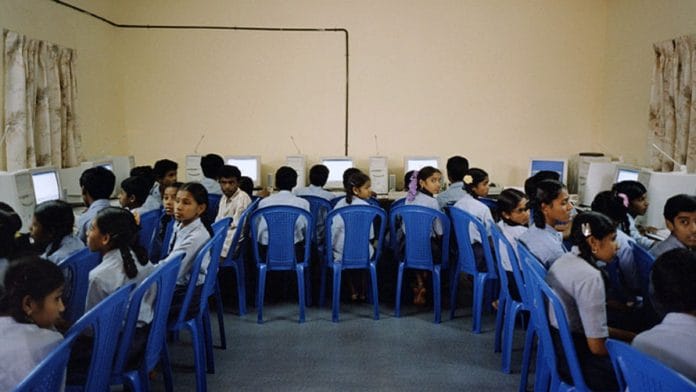New Delhi: Schools in India continue to face challenges in digital learning, with 82.7 percent districts scoring below 50 percent on this indicator in 2023-24, according to the Performance Grading Index for Districts (PGI-D) report released by the Union Education Ministry Wednesday.
The report evaluates 788 districts based on six parameters: learning outcomes, effective classroom interactions, infrastructure facilities, school safety and child protection, digital learning, and governance processes, and scores them out of 600.
The states and Union Territories (UTs) were categorized into different performance grades, ranging from Level 1 (Utkarsh) for scores of 90 percent and above, to Level 10 (Akanshi-3), the lowest level, for scores up to 10 percent.
Overall, no districts attained the top two performance grades in either 2022–23 or 2023–24, which, according to the ministry, indicates that there is significant scope for improvement in the coming years.
However, Barnala district in Punjab reached the third grade (Uttam-2) in 2023–24 by scoring over 70 percent, while no district achieved this level in 2022–23.
Among all parameters assessed, digital learning showed the weakest performance, with 272 districts scoring below 20 percent. Of these, 57 districts were placed in the lowest performance grade (Akanshi-3, up to 10 percent), while 215 districts fell into the ninth grade (Akanshi-2, up to 20 percent).
Beyond these, 179 districts were categorized in the eighth grade, 105 in the seventh grade, and 96 in the sixth grade, indicating that a large number of districts still struggle with foundational digital infrastructure and capabilities in schools.
Overall, 652 or 83 percent of the 788 districts covered scored less than 50 percent on the digital learning parameter in 2023-24.
This parameter includes several key indicators such as the percentage of schools with internet access for pedagogical purposes, the presence of computers or laptops used in teaching, the availability of computer-assisted learning tools like smart classrooms, the student-to-computer ratio (considering only those used for educational purposes), and the percentage of teachers trained to use digital tools in classroom instruction.
The report also highlights a significant rural-urban divide. For example, New Delhi district scored 33 out of 50 in digital learning, whereas Supaul district in Bihar managed a score of just 2 out of 50.
Also Read: Chandigarh tops, Meghalaya at bottom of Centre’s school education performance grading index
How districts fared on other parameters
According to the report, under the learning outcomes parameter, 667 0r 84.6 percent districts scored less than 50 percent in 2023-24.
“No district achieved the top three grades — Utkarsh, Uttam-1, or Uttam-2 — in either 2022–23 or 2023–24. However, 753 districts showed improvement in their outcome scores, and among them, 240 districts moved up by at least one grade level,” the report stated.
In the case of infrastructure, districts showed a decline in scores in 2023–24 from the previous year.
In 2022–23, 82 districts were in Uttam-1 (the second-highest grade), but this number dropped sharply to just two districts in 2023–24 in infrastructure parameters. The number of districts in the third grade also declined, with many now shifting to the fourth and fifth grades, indicating a broader downward trend in infrastructure performance
In the governance parameter as well, districts have shown a downward shift in performance grades. While 93 districts were in the Uttam-1 category (Grade 2) in 2022–23, this number dropped to just eight districts in 2023–24. Meanwhile, more districts have moved into the fourth and fifth grades, reflecting a decline in governance-related indicators.
(Edited by Amrtansh Arora)
Also Read: For the first time, more girls passed Class 12 with science than arts in 2024, shows govt data






